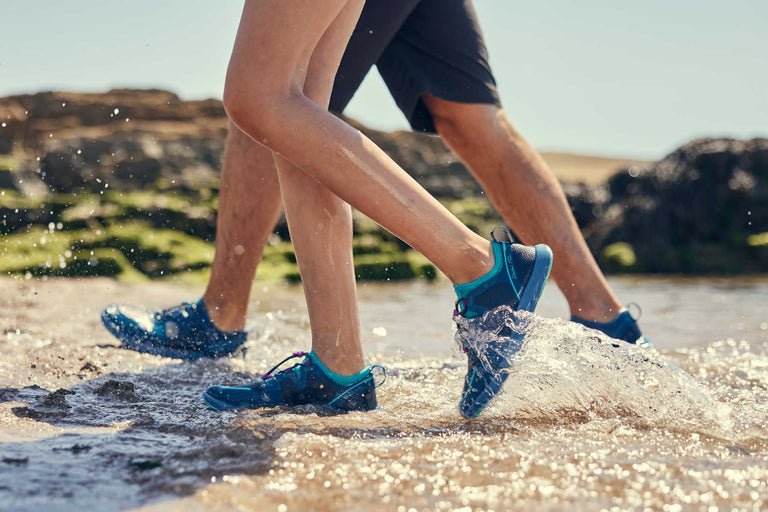
Imagine a shoe designed for both land and sea, providing you with comfort, functionality, and protection. Rising in popularity over recent years, these versatile aqua shoes have a rich history evolving from simple water sandals to the dynamic water-to-land footwear we see today. Whether you’re wading through a rocky river, hiking treacherous terrains, or simply strolling on a sunny beach, the versatility of this footwear makes it an essential item for your outdoor activities. This article will delve deep into their unique design and explore why these are a must-have in your adventure gear.
Exploring the Varieties of Aqua Shoes
When it comes to water shoes, the choice material is often a quick-drying, breathable fabric that allows water to flow freely while keeping any debris out. The soles are typically made of high-quality rubber for grip and flexibility, crucial to tackling varied terrain. These shoes also come with unique attributes like a tight cinch cord for a secure fit, an easy slip-on design, and drainage holes to keep your feet dry.
Aqua shoe designs cater to every kind of outdoor enthusiast. From lightweight slip-ons perfect for a beach day to sturdy lace-ups meant for water hiking, there’s a type tailored to suit every activity and foot shape. Some types even have thermal protection for freezing waters. Check out https://threo.com.au/t/aqua-shoes/ to see the various designs catering to every kind of outdoor enthusiast, from standard water shoes to wetsuit socks.
Uses and Advantages of Water Shoes
Swimming shoes have gained popularity among both recreational and professional outdoor enthusiasts. These hybrid shoes offer ample advantages and uses, both in water and on land.
Use in Water
Swimming shoes have been specifically designed to provide comfort, support, and protection in various water-related activities. They are commonly used in swimming, snorkeling, and scuba diving. When swimming, these shoes prevent unpleasant encounters with sharp rocks, sea urchins, or broken shells. Divers and snorkelers benefit from this footwear, not only for the protection they provide against underwater elements but also for the comfort they offer when treading on rocky or uneven seabeds.
Use on Land
Beyond their aquatic use, they also satisfy terrestrial requirements. Owing to their multifaceted design, they are ideal for activities like hiking and running. The robust construction of these shoes keeps feet secure on uneven terrains and protects against sharp objects. Furthermore, because of their stylish and contemporary designs, they can easily be worn as casual footwear, blending functionality with fashion.

Key Considerations for Making the Right Choice
- The primary step towards landing the perfect pair involves identifying the specific activity you’d use them for. Whether it’s beachcombing, snorkeling, or hiking, each activity demands a unique fit and feature;
- In terms of size, a snug fit, which neither pinches nor allows slipping, is desirable;
- The chosen material should be robust, quick-drying, and capable of enduring the rigors of both water and land activities;
- Although tempting to cut corners on cost, investing in a reputable brand often ensures better quality, durability, and a more rewarding experience.
Expert Tips for Aqua Shoe Fitting and Purchase
- To ensure the ultimate fit, try on the shoes with the type of socks you intend to wear during your activity, such as neoprene socks for cold water. Walk around the store to ensure comfort and flexibility;
- When ordering online, check the company’s size guide as sizes can vary between brands;
- Consider choosing a pair that offers a return or exchange policy.
Misconceptions and Busting Myths about Water Shoes
Despite the manifold benefits, there are some common misconceptions about their use and functionality.
Myth 1: Aqua Shoes are Only for Water Activities
Contrary to popular belief, the use of swim shoes isn’t limited to water-based activities like swimming, snorkeling, or scuba diving. They are equally effective on land. Able to stand up to challenging terrains, they are perfect for hiking and running. Blending sleek design with functionality, they can also be used as everyday footwear. Truly, they are more versatile than they are usually credited for.
Myth 2: They Don’t Offer as Much Protection
Some people might believe that due to their lightweight design, they may not provide as much protection as regular sports shoes. This couldn’t be further from the truth. These shoes offer robust protection against sharp and hazardous objects both in water and on land. The thick soles, despite being insubstantial, are designed to safeguard your feet from injury, proving that protection isn’t solely a function of weight or bulk.
Myth 3: Lack Traction
The image of water shoes having slippery soles is another misconception that merits debunking. In reality, this footwear is designed with specially engineered soles that provide excellent traction. They reduce the risk of slipping on wet and uneven surfaces, proving to be reliable footwear for safety-conscious adventurers or athletes.




